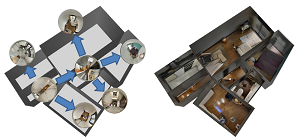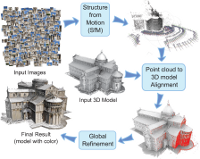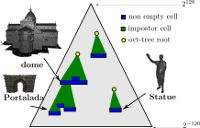At the present I'm working on a few subfields of CG: here please find some examples.

|
Indoor acquisition from photographs Acquiring indoor environments can be done by conventional 3D laser scanning
but form many applications is technically an overshotting and not cost effective. With these work we explore 3D acquisition of indoor environments from digital cameras. |

|
Presentation of 3D Scenes Using synthetic videos to present a 3D scene is a common requirement for architects, designers, engineers or Cultural Heritage professionals however it is usually time consuming and, in order to obtain high quality results, the support of a film maker/computer animation expert is necessary. We introduce an alternative approach that takes the 3D scene of interest and an example video as input, and automatically produces a video of the input scene that resembles the given video example
|

|
eXploreMaps: Efficient Construction and Ubiquitous Exploration of Panoramic View Graphcs of Complex 3D Environments
This is a method for allowing browsing of arbitrarily complex model on low powered devices with photorealistic rendering.
The idea is that, in a offline preprocessing step, we launch an exploration algorithm that create a visit graph of the model and then we
make a panoramic images for each node of the graph and a panoramic video for each arc conncting two nodes.
The result is a constrained but compelling browsing.
|

|
Fully Automatic Registration of Image Sets on Approximate Geometry
This work was done to make the registration of a collection of images to geometry automatic.
We created a three stages pipeline:
First stage: use Structure From Motion (SFM) on the image set in order to generate a sparse point cloud.
Second stage: Aligned the point cloud to the 3D object using an extension of the 4 Point Congruent Set (4PCS) algorithm for the alignment of range maps.
Third stage: a global refinement algorithm based on mutual information optimizes the color projection of the aligned photos on the 3D object, in order to
ob-tain high quality textures.
|

|
OCME: out-of-core Mesh Editing Made Practical
OCME (Out-of-Core Mesh Editing) is a novel data-structure and related algorithms for out-of-core editing
of large meshes. OCME uses a hashed multigrid where the triangles are inserted on the base of their size and position.
This choice allows a rapid access and, on average, a constant construction time per triangle.
Unlike previous approaches, no explicit hierarchy is maintained and therefore insertion/modification/deletion of data does not require
costly refitting procedures. OCME stores attributes locally, for example it allows to assign vertex color only to a small subparts of the dataset,
and naturally handles multiple-scale datasets.
|
